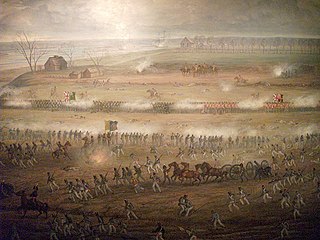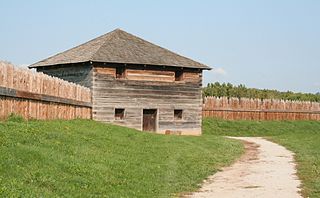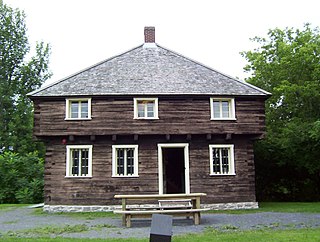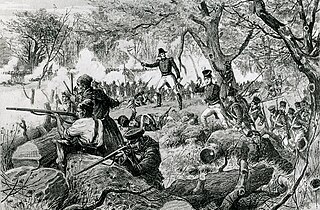
The Battle of Crysler's Farm, also known as the Battle of Crysler's Field, was fought on 11 November 1813, during the War of 1812. A British and Canadian force won a victory over a US force which greatly outnumbered them. The US defeat prompted them to abandon the St. Lawrence Campaign, their major strategic effort in the autumn of 1813.

Commodore Arthur Sinclair was an early American naval hero, who served in the U.S. Navy during the Quasi-War with France, the First Barbary War and in the War of 1812. His three sons also served in the Navy; they resigned in 1861, however, to serve in the Confederate Navy.

The Battle of Bladensburg was a battle of the Chesapeake campaign of the War of 1812, fought on 24 August 1814 at Bladensburg, Maryland, 8.6 miles (13.8 km) northeast of Washington, D.C.

The siege of Fort Meigs took place in late April to early May 1813 during the War of 1812 in northwestern Ohio, present-day Perrysburg. A small British Army unit with support from Indians attempted to capture the recently constructed fort to forestall an American offensive against Detroit, and its Fort Detroit in the Great Lakes region which the British from the north in Canada had captured the previous year. An American sortie and relief attempt failed with heavy casualties, but the British failed to capture the fort and were forced to raise the siege.

The siege of Detroit, also known as the surrender of Detroit or the Battle of Fort Detroit, was an early engagement in the War of 1812. A British force under Major General Isaac Brock with Native American allies under Shawnee leader Tecumseh used bluff and deception to intimidate U.S. Brigadier General William Hull into surrendering the fort and town of Detroit, Michigan, along with his dispirited army which actually outnumbered the victorious British and Indians.
The Raid on Gananoque was an action conducted by the United States Army on 21 September 1812 against Gananoque, Upper Canada during the War of 1812. The Americans sought to plunder ammunition and stores to resupply their own forces. Gananoque was a key point in the supply chain between Montreal and Kingston, the main base of the Provincial Marine on the Great Lakes. Under the command of Captain Benjamin Forsyth, the Americans departed Ogdensburg, New York and sailed to Gananoque, where they encountered resistance from the 2nd Regiment of Leeds Militia. The British militia was forced to retreat and the Americans successfully destroyed the storehouse and returned to the United States with captured supplies. As a result of the raid, the British strengthened their defences along the St. Lawrence River.

The Battle of Lacolle River was fought on November 20, 1812, during the War of 1812. In this relatively light skirmish, a very small garrison of Canadian militia, with the assistance of Kahnawake Mohawk warriors, defended the Lacolle Mills Blockhouse on the Montreal road bridge over the Lacolle River at the village of Lacolle, Quebec against a disorganized American attack.

The Battle of Lacolle Mills was fought on 30 March 1814 during the War of 1812. The small garrison of a British outpost position, aided by reinforcements, fought off a large American attack.

The Battle of Mackinac Island was a British victory in the War of 1812. Before the war, Fort Mackinac had been an important American trading post in the straits between Lake Michigan and Lake Huron. It was important for its influence and control over the Native American tribes in the area, which was sometimes referred to in historical documents as "Michilimackinac".
Benjamin Forsyth was an American officer of rifle troops in the War of 1812 between Britain and the United States. Born in North Carolina, Forsyth joined the United States Army in 1800 as an officer and was a captain of the Regiment of Riflemen at the outbreak of war in 1812. He led raids into Upper Canada along the Saint Lawrence River in 1812–13 before transferring south and taking part in the battles of York and Fort George. Promoted to brevet lieutenant colonel, he held a command along Lake Champlain. Forsyth was killed in June 1814 at Odelltown, Lower Canada.

When the United States and the United Kingdom went to war against each other in 1812, the major land theatres of war were Upper Canada, Michigan Territory, Lower Canada and the Maritime Provinces of Nova Scotia, New Brunswick, Prince Edward Island and Cape Breton . Each of the separate British administrations formed regular and fencible units, and both full-time and part-time militia units, many of which played a major part in the fighting over the two and a half years of the war.
The series of Engagements on Lake Huron left the British in control of the lake and their Native American allies in control of the Old Northwest for the latter stages of the War of 1812.
Miller Worsley was an officer in the Royal Navy, best known for playing a major part in the Engagements on Lake Huron in the Anglo-American War of 1812.
The Battle of Malcolm's Mills was the last battle of the War of 1812 fought in the Canadas. A force of American mounted troops overran and scattered a force of Canadian militia. The battle was fought on November 6, 1814, near the village of Oakland in Brant County, Upper Canada, and was part of a series of battles fought by American Brigadier General Duncan McArthur on an extended raid into Upper Canada, known variously as McArthur's Raid or Dudley's Raid. Marching over 200 miles (320 km) into Canada, the Americans returned to Detroit on November 17 after 11 days of raiding the Ontario Peninsula.

Lacolle is a municipality in southern Quebec, Canada, located in the administrative area of the Montérégie, on the Canada–United States border. The population as of the Canada 2011 Census was 2,680. The Lacolle River runs eastward through the middle of the town and empties in Richelieu River. More people cross the border illegally from the United States there than at any other point. Almost nineteen thousand people were detained in 2017. The nearest town across the border is Champlain, New York.

The Regiment of Riflemen was a unit of the U.S. Army in the early nineteenth century. Unlike the regular US line infantry units with muskets and bright blue and white uniforms, this regiment was focused on specialist light infantry tactics, and were accordingly issued rifles and dark green and black uniforms to take better advantage of cover. This was the first U.S. rifleman formation since the end of the American Revolutionary War 25 years earlier.
Where can you find troops more efficient than Morgan's riflemen of the Revolution or Forsyth's riflemen of the last war with Great Britain?
United States Rangers were originally raised for Tecumseh's War, but they continued to serve against hostile Indians after the United States declaration of war against Great Britain. A total of 17 independent companies were authorized from Kentucky, Ohio, Indiana, Illinois and Missouri. The Rangers were neither militia, nor regulars, but formed part of the war establishment of the United States as volunteers.
100 American soldiers stationed at French Mills led a successful attack against 45 Canadian voyageurs on October 22 at the Battle of St. Regis. Half returned to French Mills while the other half departed for Plattsburgh, New York. In retribution, a mix of Canadian regulars and militia amounting to 150 men attacked the 50 Americans at French Mills forcing their surrender.
During the War of 1812, on October 11, 1813, an American expeditionary force entered the Missisquoi Bay of Lake Champlain in Quebec, Canada, intent on raiding the area. Their goal was to stop smuggling goods across the border. They succeeded in defeating a contingent of Canadian militia and raid the town of Philipsburg, Quebec.










